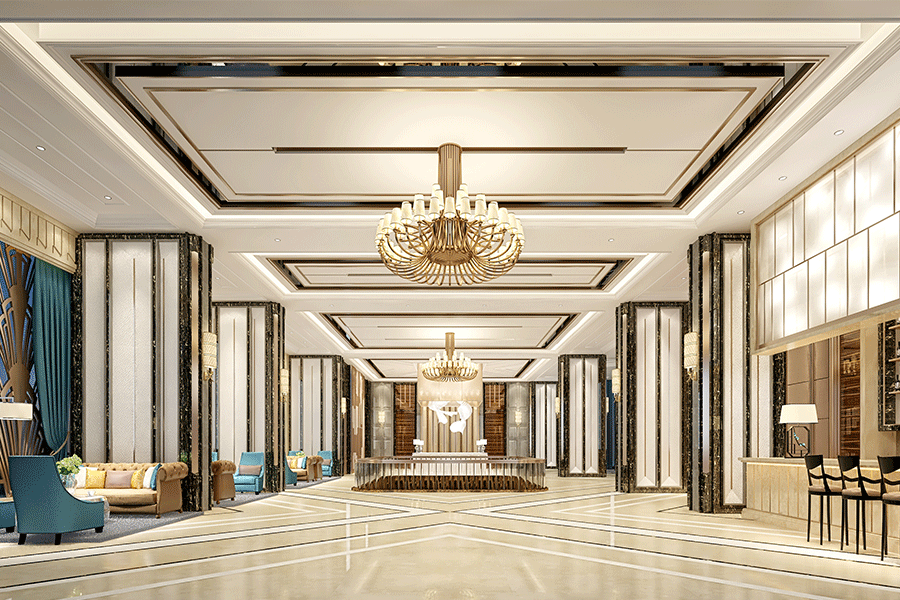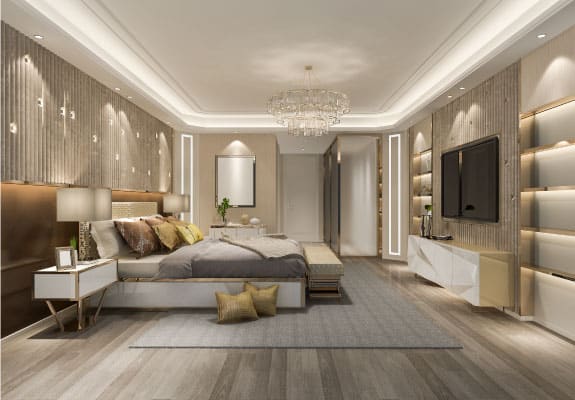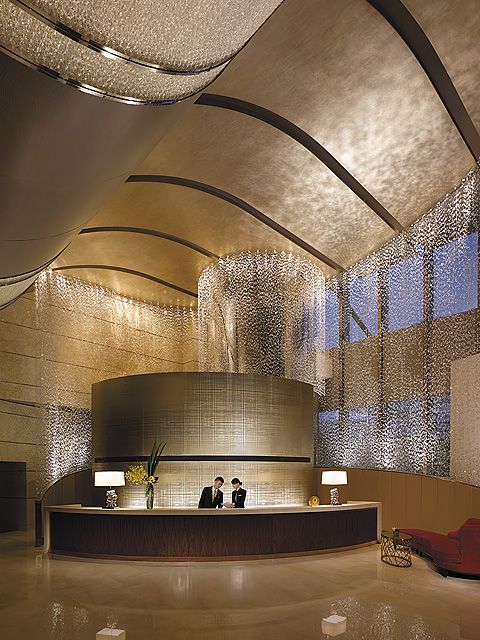Ultimate Guide to Hotel Lighting
Table of Contents
Hotel Lighting plays a pivotal role in defining the ambiance of a hotel or any other hospitality establishment. Hence, the right lighting setup is critical to delivering premium customer service. In a fiercely competitive hospitality landscape, pairing appropriate light fixtures with well-thought-out hotel lighting designs can be a game-changer.
It’s essential not to hastily install lighting solutions in the hope of creating an enticing aesthetic. High-end furniture and interior designs require equally exceptional lighting to exude a luxurious feel. This article guides those exploring lighting solutions for hotels, providing all the necessary information before embarking on a lighting project.

What does Hotel Lighting entail?
At its basic level, hotel lighting involves illuminating a hotel with suitable solutions. However, this bare-bones definition hardly covers the complexities involved. Different hotel segments serve different functions and therefore demand distinct lighting needs. A one-size-fits-all lighting approach for all hotel areas would result in a monotonous and unattractive look.
It’s important to recognize that the lighting needs of areas such as guest rooms, the lobby, hallways, staircases, and the reception vary greatly. Hence they need to be illuminated accordingly. Exceptional hotel lighting attracts more guests and opens up new avenues for increased profitability.
The Significance of Lighting in Hotels
Previously, we highlighted the critical role of lighting in hotel settings, emphasizing its equal importance to interior design. Consider the scenario where massive amounts were expended on interior décor, but lighting was overlooked. Despite the substantial investment, poor illumination could render the hotel uninviting. On the other hand, optimal lighting can enhance the hotel’s attractiveness, promoting a comfortable and welcoming atmosphere for guests. It can also spotlight certain design elements you wish to emphasize.
A tasteful interior coupled with superior lighting can potentially elevate a hotel’s reputation, making it one of the most sought-after lodgings in the area.
Another factor worth deliberating is the cost-saving potential of good lighting. Utilizing incandescent bulbs, for instance, can spike energy costs, thereby increasing operational expenses. Conversely, opting for cost-efficient alternatives like LEDs can save energy bills and overall operational costs. The saved funds can then be reinvested into other high-return aspects of the hotel.

Understanding the Value Addition of Hotel Lighting
Implementing suitable hotel lighting strategies can attract more clientele and increase revenue. Let’s delve into how quality lighting achieves this.
1. Mood Enhancement
Lighting has a profound influence on an individual’s mood. Lackluster lighting can give guests a sense of boredom, regardless of how impressive the interior design may be. It can prevent them from fully appreciating the intricate details of the décor. Contrastingly, excellent lighting can make the place photogenic, an essential aspect many travelers look for in their accommodation choices.
It’s worth noting that people often remember a location based on how it made them feel. If a hotel’s lighting can help foster a positive mood among guests throughout their stay, they are more likely to endorse it to their network.
2. Sensory Activation
Beyond detracting from interior aesthetics, insufficient lighting can cause visitors to feel lethargic. This is due to the production of a hormone called ‘melatonin,’ which is known to induce sleep and is more active in darker environments. In the absence of appropriate lighting, guests may consistently feel fatigued. However, melatonin production can be controlled with proper lighting, ensuring guests stay alert and engaged.
3. Ensuring Convenience
Well-executed lighting designs contribute to a guest’s comfort, which is especially crucial for those who need to perform work tasks within their rooms. Moreover, inadequate lighting can create difficulties in tasks as simple as getting dressed before heading out, leaving an unfavorable impression on guests and possibly deterring them from returning. In contrast, a well-lit space promotes a conducive atmosphere for guests to concentrate on tasks. This positive experience increases the chances of guests recommending your hotel to others.

Exploring Different Hotel Lighting Options
When embarking on the search for hotel lighting, you will discover a variety of choices. LEDs, Halogen lights, and incandescent bulbs are the most widely recognized and prominent. Each of these lighting options brings its advantages and drawbacks to the table. Hence, assessing your needs and selecting the best-suited lighting solution for your hotel is essential.
Incandescent bulbs are generally less prevalent in hotels, primarily due to their high operational cost and the need for frequent replacements. Their only advantage lies in their initial affordability.
Halogen bulbs, the evolved variants of incandescent bulbs, present a slightly more economical option. However, LEDs surpass both in terms of efficiency and cost-effectiveness. These luminaires are the most economical choice in the long run and provide superior durability. In addition, LEDs offer various design options, adding to their flexibility and enabling you to create an impactful lighting design.
Despite their higher upfront cost, LEDs are advantageous in the longer term. They lead to significant energy savings and eliminate the trouble of replacing fixtures every few months, making them worth the initial investment.
What are the steps to follow to design the lighting of a hotel?
A good hotel doesn’t have 5 stars, but it does have to feel the guest at ease, like at home, with an enveloping and hospitable atmosphere. The hotel’s lighting contributes significantly to the guest experience, not for the function linked to visibility and for the emotions it can arouse. The atmosphere you must recreate with the right lights must be welcoming, pleasant, and functional to allow guests to find their way around easily and comfortably in every hotel room.
- In the hotel lobby, the relationship between the function and the decoration given lighting must be so harmonious as to create an atmosphere that knows how to affect the guest’s first impression from the moment they arrive.
The light that welcomes guests is responsible for leaving in their memory a good memory. - On the other hand, light must take on a more practical but flexible role in the rooms. It will be necessary to offer the possibility to adjust it according to your needs. Adopt a lighting system that can adapt to the guest’s needs; it allows him to independently and extemporaneously recreate the atmosphere most of his welcome, dictated by his mood.
- If the hotel has a function room, an area for conferences and meetings, very flexible lighting is required to meet different activities in this space.
In these cases, the lighting must be managed using an adequate control system that all personnel can easily maneuver. - As for the lighting of the restaurant and the bar area, the lights play a decisive role in distinguishing spaces, shaping the atmosphere more appropriate for different environments.
Walkways used by staff, for example, are generally brighter light at the tables or seats. In restaurants, using a soft light with a warm hue for dinners is preferable to create a relaxing and intimate atmosphere. For breakfast and lunch, however, it is best to integrate with abundant natural lighting or use lighting with brighter and more stimulating shades.
Essential Considerations Before Lighting a Hotel
Once you grasp the fundamentals of hotel lighting, here are some key considerations to remember when choosing lights for your establishment.
1. Minimize Glare
Moderation is key when it comes to lighting a hotel. Overly bright interior lighting can result in Glare, which can be uncomfortable for visitors’ eyes. While illumination should be sufficient to highlight all interior elements, it should not be so intense as to create Glare. A typical lux light level for hotels is around 150, but this can vary greatly depending on the amount of natural light entering the space.
Consider investing in anti-glare solutions, despite their potentially higher cost. The benefits they bring are well worth the investment.
2. Align Lighting Distribution with Needs
Different sections of a hotel have different lighting needs, necessitating appropriate allocation. It’s not advisable to excessively brighten one area while leaving others dim. Instead, you should adjust your hotel’s lighting to match each area’s specific needs. For instance, the lights for hallways may not be suitable for bedrooms due to differing requirements.
3. Consider Color Temperature
Color temperature, measured on a Kelvin scale, is a critical factor in hotel lighting as it determines the color of light produced. Different color temperatures affect occupants’ moods differently. Color temperatures typically range from 1,000 to 10,000 K. Lights under 3,000K emit a warm glow that fosters a cozy ambiance, while lights above 4,000K cast cool, natural-like light that encourages activity.
It’s advisable to use lighting with a temperature above 4,000K in work-oriented areas. Lights under 4,000K are more suitable for bedrooms or areas with a homely vibe.
4. Evaluate Color Rendering Index (CRI)
As vital as color temperature, the CRI plays a different but significant role. It assesses how well artificial light replicates the accuracy of colors as they would appear under natural light, measured on a scale from 0-100. A higher CRI brings colors closer to their natural appearance.
However, using lights with a high CRI everywhere in your hotel is unnecessary. Some interior features may look better under lower CRI lighting. Understanding how CRI impacts your hotel’s lighting will help you choose appropriate fixtures.

Guidelines for Lighting a Hotel
Hotels have diverse needs when it comes to lighting, but some core principles are universally applicable, irrespective of hotel size or interior design. Here’s a strategic approach to implementing effective hotel lighting.
1. Study the Hotel’s Design
The first step in creating a successful lighting plan is to thoroughly assess the hotel’s design and determine how the lighting will function in this environment. If lights exist, their strengths and weaknesses can guide modifications for the new scheme. A meticulous vision of the desired look is essential. Once this is established, further steps can be taken.
2. Emphasize Energy Efficiency
The dual goals of hotel lighting are enhancing utility and atmosphere. These can be realized through energy-efficient solutions such as LED lights. These are the ideal choice due to their energy conservation and superior durability. Additionally, the wide variety of LEDs will facilitate the actualization of your envisioned design.
3. Establish a Consistent Theme
After finalizing the design and selecting the appropriate lighting, choosing a distinctive theme for the hotel lighting is essential. It should be unique, imbued with its character. The lighting should enhance the hotel’s identity and uplift the overall ambiance. While inspiration can be gleaned from other establishments, copying their designs should be minimal. Each hotel’s unique interiors demand a distinct lighting approach.
4. Ensure Comprehensive Lighting Coverage
Each part of the hotel deserves careful attention in the lighting plan. The exterior landscape and façade should be considered alongside the interior. Various elements within the interior each require lighting considerations. Overemphasis on room interiors at the expense of corridors can result in an overall dull and visually unappealing effect.
Note that consistency in lighting tone throughout the hotel is essential. An overly vibrant color palette can create a discomforting environment for guests.
5. Offer Adjustable Options
Different guests have unique lighting needs, which can be catered to with adjustable lighting options. Lights with variable temperatures allow guests to adjust settings to their preferences. Smart LEDs also offer flexibility, allowing guests to control brightness, temperature, and light color.
Adaptable lighting solutions can make a single room appealing to various guests based on their individual needs.

How To Create Lighting According to the Non-Standard Hotel Styles
Hotels have different themes and styles, which require necessary lighting changes accordingly. Let us take a look at these non-standard hotel styles and how you can make changes to them.
A non-standard hotel caters to special visitors like tourists or certain groups. These may include hotels that provide specific services for honeymoon couples or adults. In most cases, visitors to these kinds of hotels usually look for fun and memorable experiences, so ensuring they get a comfortable and memorable time here is important. If your hotel has large structures or statues, use direct light to make them more visible at night.
Similarly, if your hotel is located at a good location, try to use lighting to your advantage to make the hotel stand out. The more unique your hotel looks, the more people want to visit it. You can also add a souvenir or gift shop here to sell more products.
Optimizing Your Hotel’s Lighting: A 10-STEP GUIDE
You’re already familiar with the essentials of illuminating your hotel space. Let’s dive deeper and look at how you can further enhance your establishment’s lighting:
- Engage a professional lighting designer to do the job. Their expertise can provide the best insight into which design complements your hotel’s unique style and ambiance.
- Embrace natural light to its fullest. Encourage sunlight to permeate the rooms, enlivening your guests’ moods and invigorating their spirits.
- Be mindful of ceiling heights, as they dramatically affect the impact of a light fixture on a space. The selection of fixtures should consider the ceiling heights across different areas in the hotel.
- Carefully consider areas where light from different sources intersect. These transitions should be gradual and discreet.
- Make your lobby area come alive with more daring, colorful lighting solutions, ensuring that any changes do not compromise the functionality of the space.
- Prioritize safety when illuminating hallways, staircases, and parking lots. It’s crucial to prevent guests from tripping and hurting themselves during their stay.
- Use task-oriented lights, like spotlights, in spaces dedicated to hosting events.
- Some hotels feature open, flowing spaces. These can be separated into distinct areas using different lighting schemes.
- Again, safety is paramount when lighting hallways, staircases, and parking lots. Your lighting design should help guests navigate these areas without incident.
- Remember that hotel lighting consumes a sizable chunk of the establishment’s total energy. Selecting energy-efficient lights can reduce your energy costs and operational expenses.
Wrapping up
Hotel lighting involves much more than simply installing fixtures in rooms and corridors. It requires careful consideration of numerous factors. The right lighting can significantly enhance the value of your hotel. Therefore, when deciding on lighting solutions, remember to keep them uncomplicated and effective.
MyLikeLed produces top-tier LED strips and LED neon flex, all thoroughly tested in our advanced labs to guarantee maximum quality. We also provide customization options for our LED strips and neon flex. For superior LED strip and LED neon flex solutions, contact MyLikeLed today!
FAQs
The main types of hotel lighting are ambient, task, accent, and decorative lighting. Each serves a different purpose — ambient provides overall illumination, task lighting helps with activities like reading, accent highlights features like artwork, and decorative adds style and charm.
Hotel lighting improves guest satisfaction by making rooms feel cozy, functional, and luxurious. Thoughtfully placed lights can make guests feel relaxed and cared for, leading to better reviews and repeat bookings.
Soft, layered lighting is best for hotel lobbies. Combining overhead fixtures, floor lamps, and accent lights creates a warm, inviting atmosphere while showcasing design details and helping guests feel comfortable upon arrival.
Hotel room lighting should be designed with flexibility and comfort in mind. It’s best to offer multiple light sources — such as bedside lamps, desk lights, and ceiling fixtures — so guests can adjust brightness for sleeping, working, or relaxing.
Yes, hotels have many energy-efficient lighting options like LED bulbs and smart lighting systems. These not only reduce energy costs but also last longer, require less maintenance, and support eco-friendly practices.

Hi, I’m Xylia Xiong, a sales professional with 14 years of experience in the LED strip light industry. I specialize in providing tailored solutions, leveraging my expertise in LED products and the latest industry trends. Known for effective communication and problem-solving, I’m dedicated to helping lighting manufacturers, importers, and distributors achieve their goals.
Let’s work together to create customized solutions that exceed expectations.
Related Posts

The Best LED Strip Lights You Can Buy Right Now

Comparing WS2811 Vs WS2812B: Key Differences


